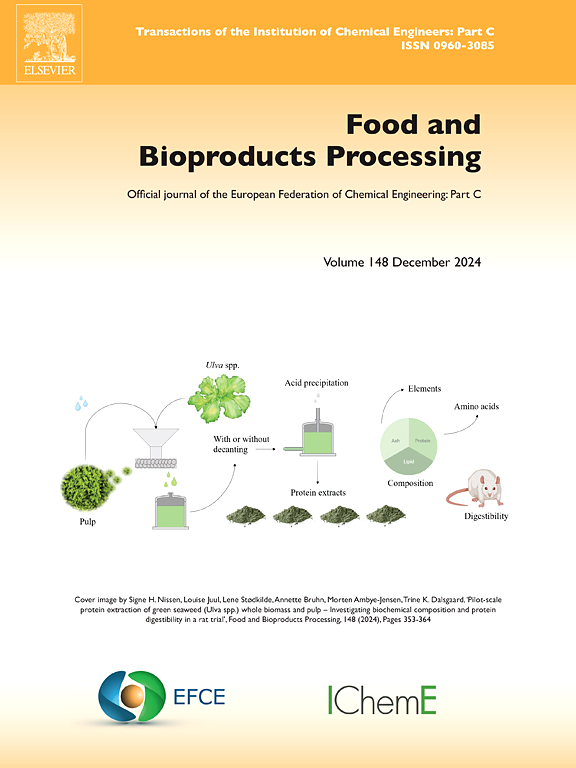利用超临界流体萃取技术从秋葵中提取富含异黄酮的提取物:动力学建模与表征
IF 3.5
2区 农林科学
Q2 BIOTECHNOLOGY & APPLIED MICROBIOLOGY
引用次数: 0
摘要
采用超临界流体萃取法萃取了大豆加工副产品黄卡拉中的脂质部分和生物活性化合物。研究了压力(20-40 兆帕)、温度(40-80 ºC)和共溶剂用量(0-10 % 重量百分比乙醇)等操作参数对萃取动力学的影响,实验数据与索沃娃模型的相关性令人满意。在20兆帕和80摄氏度时,SFE的萃取率为0.1014克萃取物/克不溶性固体(IS);在30兆帕和60摄氏度时,萃取率为0.1081克萃取物/克不溶性固体(每100克黄原胶的萃取率分别为9.2克到9.8克),与使用正己烷的索氏萃取(9.2 ± 0.2克萃取物/100克)相似。压力对初始萃取率有积极影响,除了最低压力为 20 兆帕外,萃取率也随温度升高而增加,表现出典型的交叉行为。使用乙醇作为助溶剂可促进酚类化合物和异黄酮的萃取,但对生育酚的萃取影响较小。在 40 兆帕和 40 ºC 条件下,乙醇的萃取率最高可达 0.1100 克萃取物/克 IS。不出所料,sc-CO2 + 乙醇提取物中生物活性化合物含量较高,对抗氧化能力产生了积极影响,在 20 兆帕、40 ºC 和 10 %wt.本文章由计算机程序翻译,如有差异,请以英文原文为准。
Isoflavone-rich extracts from okara using supercritical fluid extraction: Kinetic modeling and characterization
The lipid fraction and bioactive compounds from okara, a by-product of soybean processing, have been extracted by supercritical fluid extraction. The effect of operating parameters, pressure (20–40 MPa), temperature (40–80 ºC), and cosolvent usage (0–10 %wt. ethanol), on the extraction kinetics has been investigated, satisfactorily correlating the experimental data to the Sovová’s model. Extraction yield by SFE ranged from 0.1014 g extract/g insoluble solid (IS) at 20 MPa and 80 ºC to 0.1081 g extract/g IS at 30 MPa and 60 ºC (from 9.2 to 9.8 g extract/100 g okara, respectively), similar to Soxhlet extraction with n-hexane (9.2 ± 0.2 g extract/100 g). Pressure positively affected the initial extraction rate, which also increased with temperature except for the lowest pressure of 20 MPa, exhibiting a typical cross-over behavior. The use of ethanol as cosolvent promoted the extraction of phenolic compounds and isoflavones, and was less important in the extraction of tocopherols. Extraction yield using ethanol increased up to 0.1100 g extract/g IS at 40 MPa and 40 ºC. As expected, the higher content of bioactive compounds in the sc-CO2 + ethanol extracts positively affected the antioxidant capacity, with the maximum found at 20 MPa, 40 ºC and 10 %wt. ethanol.
求助全文
通过发布文献求助,成功后即可免费获取论文全文。
去求助
来源期刊

Food and Bioproducts Processing
工程技术-工程:化工
CiteScore
9.70
自引率
4.30%
发文量
115
审稿时长
24 days
期刊介绍:
Official Journal of the European Federation of Chemical Engineering:
Part C
FBP aims to be the principal international journal for publication of high quality, original papers in the branches of engineering and science dedicated to the safe processing of biological products. It is the only journal to exploit the synergy between biotechnology, bioprocessing and food engineering.
Papers showing how research results can be used in engineering design, and accounts of experimental or theoretical research work bringing new perspectives to established principles, highlighting unsolved problems or indicating directions for future research, are particularly welcome. Contributions that deal with new developments in equipment or processes and that can be given quantitative expression are encouraged. The journal is especially interested in papers that extend the boundaries of food and bioproducts processing.
The journal has a strong emphasis on the interface between engineering and food or bioproducts. Papers that are not likely to be published are those:
• Primarily concerned with food formulation
• That use experimental design techniques to obtain response surfaces but gain little insight from them
• That are empirical and ignore established mechanistic models, e.g., empirical drying curves
• That are primarily concerned about sensory evaluation and colour
• Concern the extraction, encapsulation and/or antioxidant activity of a specific biological material without providing insight that could be applied to a similar but different material,
• Containing only chemical analyses of biological materials.
 求助内容:
求助内容: 应助结果提醒方式:
应助结果提醒方式:


